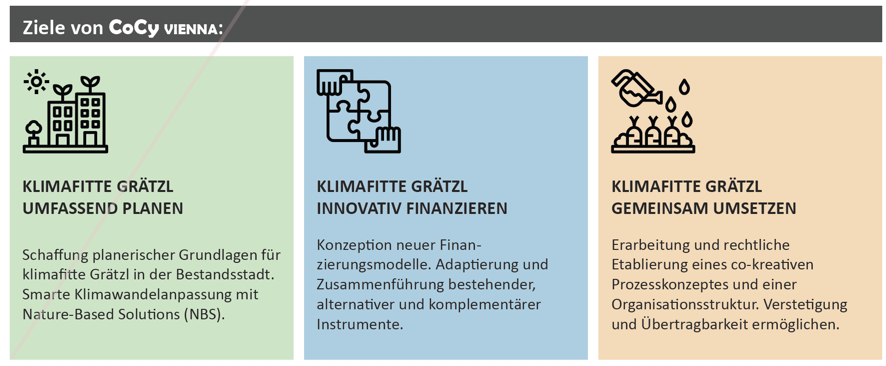Co-creation and Green Finance methods for effective and rapid implementation of Nature-Based Solutions for climate change adaptation in cities.
Vienna

Status
ongoing
Period
04/2021–03/2024
Website
smartcities.at/projects/collaboration-city
Funding
Klima-und Energiefond Österreich
Consortium leader
Green4Cities (G4C)
Team G4C
Doris Schnepf, Elisabeth Olesko, Bernhard König, Oliver Weiss
Collaboration City –
The innovative pathfinder to the climate model city Vienna
Smart and forward-looking urban planning responds to climate change and designs local measures to adapt to changing climatic conditions: In the Grätzl, both the goals of the European Green Deal and the climate strategy goals of the City of Vienna can be put into practice. The innovative research and development project COLLABORATION CITY demonstrates how a Grätzl can be comprehensively redesigned to be climate-friendly and socially just. The starting point for this is “Nature-Based Solutions” (NBS) – i.e. solutions inspired and supported by natural processes. As a lighthouse project of the Climate Model City Vienna, the project is to prepare further implementations.
Bringing together 5 fields of action – together we can do it!
The fields of action NBS planning, mobility, energy, governance/participation and financing are decisive for the implementation of climate-smart Grätzl. Coordinated with each other, they unfold their full potential in a co-creative process that keeps an eye on social balance. In the demonstration area of COLLABORATION CITY, intelligent mobility concepts create space for unsealing measures that are implemented as blue and green infrastructure with Nature-Based Solutions. A financing portfolio of public and private funds bears both the installation and long-term maintenance costs. Innovative financing models such as a “token system”, “environmental impact bonds” or “crowd investments” are part of this portfolio. The project follows a co-creative process design for the active participation of local actors, as well as an organizational structure that integrates both residents and administration and involves local stakeholders in the Grätzl as investors.
